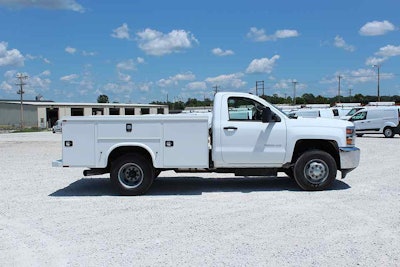
(Note: This is the third in a series of articles examining materials used in service body construction. The first article is titled Service bodies: Part 1, Reading talks aluminum and the second is Service bodies: Part 2, Stahl gets tough with polypropylene.)
 Tony Marshall, product manager at Knapheide
Tony Marshall, product manager at KnapheideTony Marshall, product manager at Knapheide, answered questions about the type of materials used to build Knapheide bodies.
HWT: What’s the most popular material used to construct Knapheide service bodies?
Marshall: Currently, the material used by Knapheide for our service body offerings is a two-sided A-40 galvanneal steel. Depending on the type and style of service body (standard service body, EC series service body or KUV) we use a variety of gauges of high strength steel to accomplish a couple things. First and foremost, is the strength, security and longevity of the product that our customers expect. Second, we try to use this combination of different gauge high strength steel to optimize the strength to weight ratio to help our customers get the most out of their work trucks.
HWT: Have customers been showing a greater interest in aluminum?
Marshall: The interest for aluminum service bodies remains as a niche product, mostly limited to the snow belt of the country. Interest level and market share penetration of aluminum has been flat as we have come out of the recession. We anticipate that the interest level will gradually increase over the next several years with the propagation of aluminum panels in work trucks, like the 2017 Ford Super Duty. Knapheide will continue to listen to our customers and the market as a whole and stay committed to delivering the service body products that the industry demands.
HWT: Does Knapheide use polypropylene or other plastic materials in its service bodies?
Marshall: Knapheide currently uses an ABS material bulkhead in our KUV as a standard offering. The ABS bulkhead while lighter than the once standard bulkhead offers another great benefit. The ABS material is much quieter. For the driver that spends the majority of his day in this vehicle going from job site to job site or delivering product the rattle free quiet is a well received and welcomed upgrade. We recognize that plastics have a potential place in interior and non-structural areas of a body. We will continue to look at the feasibility of using plastics where it is an improvement to the product and does not unduly affect the financial model of the product line.
HWT: What Knapheide service body is considered to be the most durable and why?
Marshall: The standard J-Series Knapheide Service Body is the most durable. Over 50 years of commitment to product and process improvement make this body the best. We also use this same methodology in the design and assembly of our line bodies and crane bodies to deliver the best solution for those applications.
HWT: How does Knapheide help customers decide which material to spec for their service body?
Marshall: A Knapheide Service Body is primarily A40 galvanneal steel. We work with our customers to configure and design the service body to their needs.
HWT: Anything else you’d like to add?
Marshall: Knapheide Manufacturing is the leader in the service body industry.
 KSS Ford F-350
KSS Ford F-350
 KUV Ford Transit
KUV Ford Transit
 KUV Ram ProMaster
KUV Ram ProMaster
 KUV Ford Transit 250
KUV Ford Transit 250
 KUV Ford Transit 350
KUV Ford Transit 350
 KUV Ford E-350
KUV Ford E-350
 KUV Ford E-350
KUV Ford E-350
 KUV GM 3500
KUV GM 3500
 Ford service body
Ford service body
 Ford service body
Ford service body
 GM service body
GM service body
 GM service body
GM service body









